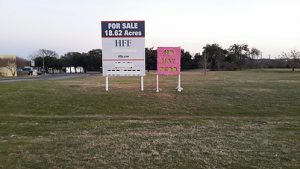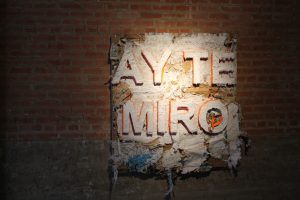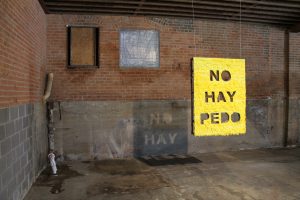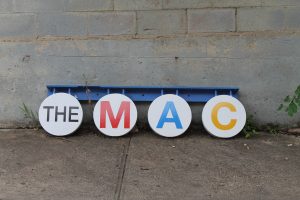Forged Utopia Begins A New Gentrification Dialogue
ArtandSeek.net June 24, 2016 22As a kid growing up in the mostly Latino neighborhood of Oak Cliff in Dallas, Giovanni Valderas used to run around his neighborhood and see lots of familiar faces in all the usual places. He remembers visiting people who lived in mobile homes and bumping into schoolmates and buddies in the apartment complexes that he ran in and out of during summer .
But these days, Valderas says, a lot of those places have been have been knocked down and flatted. He says the locations where the apartments used to be now have huge real estate signs on them and he’s wondering what this means for his predominately Latino community.

Valderas’ first sign that he hung up in the Oak Cliff neighborhood.
Photo: Giovani Valderas
“I just think it’s really interesting,” says Valderas, “what does that say about the culture we have in Oak Cliff? Will that be going away too?”
These questions about his community were the catalyst for “Forged Utopia.” Valderas created a giant sign that looks part piñata, part real estate sign. He positioned it right next to an actual real estate sign in the neighborhood to see what would come of it. “I wanted the signs to begin a dialogue with one another, but also with the community,” says Valderas.
Why Piñatas Though?
The choice to use materials similar to those for making piñatas for his painting/installation came from two places: fascination and reflection.
Valderas says he’s always been charmed with the piñata, which is why he’s incorporated it into his work. “Back in indigenous world, in Latin America, the custom of using piñatas was co-opted by Spaniards as a way of attracting the locals toward Catholicism,” says Valderas. “That’s always had me fascinated and has inspired me to make my work piñata-based in elements.”
Today, piñatas are culturally accepted by many cultures and Valderas says that was important too. “Piñatas are really tactile and festive. People are really comfortable with [piñatas] so they won’t be put off. And because of that, maybe people can just sit while they’re in traffic and think about things.”
In addition to being festive, piñatas are also temporary. Valderas constructed the signs in traditional piñata technique, with paper mache and a wooden armature underneath. That means his creations will only last at most a couple of months before they begin to disintegrate, at which point he’ll return to collect the frames. He compares it to the state of Oak Cliff: “It’s this idea of communities slowly disintegrating as what we once knew them as.”

One of Valderas’ disintegrated paintings hangs in the exhibit at the MAC.
Photo: Hady Mawajdeh
Hablas Español?
Valderas also believes that his “piñata sign” is a reflective portrait of his community, because he uses Spanish language slang on it. Since the work is intended for members of his own community, he wanted to use their vocabulary. “Saying yeah, it is this slang language, but it’s ours, we own it, it’s something really beautiful,” Valderas says. He considered including English subtitles with the exhibit but opted not to: for non-Spanish speaking visitors, that hurdle to understanding mirrors the everyday struggles of immigrants to understand and adapt to different cultures.
Several of the signs are common expressions, while others could have multiple meanings. One sign features shredded newspapers and, in bright orange and white, the words “Ay Te Miro,” an informal way to say “see you later.” Some are less polite than others: one teal sign reads “Te Jodiste,” or, “You’re screwed.” Many, however, showcase Valderas’ optimism.
 Gentrification is a shadow that looms over many communities. Photo: Hady Mawajdeh
Gentrification is a shadow that looms over many communities. Photo: Hady Mawajdeh
One such sign reads “No Hay Pedo.” According to Valderas, “that translates to something like ‘there’s no fart,’ but to native Spanish speakers it means “there’s no problem.” Valderas believes the signs are a powerful symbol of hope. Even if the neighborhood changes, he thinks, everything’s going to be okay. “Gentrification is such a complicated issue and I’m not looking for a solution,” says Valderas, “people who migrate will continue to do so and they will continue to flourish.”
Conversation, Not Solution
“Forged Utopia” is part of a series of exhibitions at the MAC, which moved from uptown to the Cedars, addressing issues related to gentrification and diversity in the area. Director of the MAC Rachel Rogerson believes that it’s important to consider the gallery’s role in the neighborhood, which has seen a similar urban transformation as the one in Oak Cliff. “I think art is often times a forebearer to gentrification, unfortunately,” she says. But she hopes that the creative nature of the Cedars will prevent the area from filling up with “high rises and expensive apartments.”

This sign hung at the MAC’s former location and followed to the Cedars.
Photo: Hady Mawajdeh
Valderas may not solve gentrification, or even seek to, but he is still dedicated to serving the community he grew up in. He says the lack of opportunities for artists of color “weighs heavy” on his mind. In his work on the Cultural Affairs Commission for the city of Dallas, which he stepped down from recently, and as assistant director of the Kirk Hopper Gallery, he has sought to create opportunities for talented minority artists who are working on or talking about relevant topics, like trying to assimilate into American culture.
When it comes to his piñata signs, the public installations are perhaps even more important than the gallery exhibition itself. He wants to reach an audience beyond gallery attendees, and, ultimately, his messages are for the community he grew up in. When he started thinking about how to reach that demographic, he decided that temporary, public art would be the best way to spark conversation.
“If someone stuck in traffic is staring at this thing and can see the links between these two objects that are so different from each other, I’m content with that.”
This article was written by Hady Mawajdeh and Frankie Paris.









